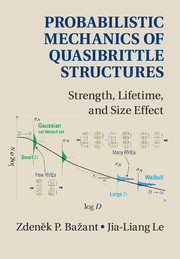Book contents
- Frontmatter
- Dedication
- Contents
- Foreword
- Preface
- 1 Introduction
- 2 Review of Classical Statistical Theory of Structural Strength and Structural Safety, and of Statistics Fundamentals
- 3 Review of Fracture Mechanics and Deterministic Size Effect in Quasibrittle Structures
- 4 Failure Statistics of Nanoscale Structures
- 5 Nano–Macroscale Bridging of Probability Distributions of Static and Fatigue Strengths
- 6 Multiscale Modeling of Fracture Kinetics and Size Effect under Static and Cyclic Fatigue
- 7 Size Effect on Probability Distributions of Strength and Lifetime of Quasibrittle Structures
- 8 Computation of Probability Distributions of Structural Strength and Lifetime
- 9 Indirect Determination of Strength Statistics of Quasibrittle Structures
- 10 Statistical Distribution and Size Effect on Residual Strength after Sustained Load
- 11 Size Effect on Reliability Indices and Safety Factors
- 12 Crack Length Effect on Scaling of Structural Strength and Type 1 to 2 Transition
- 13 Effect of Stress Singularities on Scaling of Structural Strength
- 14 Lifetime of High-k Gate Dielectrics and Analogy with Failure Statistics of Quasibrittle Structures
- Appendix A Power-Law Scaling of Boundary Value Problems
- Appendix B Proof of Transitional Size Effects of Types 1 and 2 by Dimensional Analysis and Asymptotic Matching up to Second Order
- Appendix C Proof of Small-Size Asymptotics of Cohesive Crack Model up to Second Order
- References
- Author Index
- Subject Index
14 - Lifetime of High-k Gate Dielectrics and Analogy with Failure Statistics of Quasibrittle Structures
Published online by Cambridge University Press: 14 June 2017
- Frontmatter
- Dedication
- Contents
- Foreword
- Preface
- 1 Introduction
- 2 Review of Classical Statistical Theory of Structural Strength and Structural Safety, and of Statistics Fundamentals
- 3 Review of Fracture Mechanics and Deterministic Size Effect in Quasibrittle Structures
- 4 Failure Statistics of Nanoscale Structures
- 5 Nano–Macroscale Bridging of Probability Distributions of Static and Fatigue Strengths
- 6 Multiscale Modeling of Fracture Kinetics and Size Effect under Static and Cyclic Fatigue
- 7 Size Effect on Probability Distributions of Strength and Lifetime of Quasibrittle Structures
- 8 Computation of Probability Distributions of Structural Strength and Lifetime
- 9 Indirect Determination of Strength Statistics of Quasibrittle Structures
- 10 Statistical Distribution and Size Effect on Residual Strength after Sustained Load
- 11 Size Effect on Reliability Indices and Safety Factors
- 12 Crack Length Effect on Scaling of Structural Strength and Type 1 to 2 Transition
- 13 Effect of Stress Singularities on Scaling of Structural Strength
- 14 Lifetime of High-k Gate Dielectrics and Analogy with Failure Statistics of Quasibrittle Structures
- Appendix A Power-Law Scaling of Boundary Value Problems
- Appendix B Proof of Transitional Size Effects of Types 1 and 2 by Dimensional Analysis and Asymptotic Matching up to Second Order
- Appendix C Proof of Small-Size Asymptotics of Cohesive Crack Model up to Second Order
- References
- Author Index
- Subject Index
Summary
In chapters 4–9, we studied the statistics of strength and lifetime of quasibrittle structures. The underlying approach was anchored by the weakest-link theory, in which the structure is statistically modeled as a chain of representative volume elements (RVEs). Because the size of material inhomogenieties (or, equivalently, RVE size) is not negligible compared to the structure size, this chain is not infinitely long. This causes the probability distributions of structural strength and lifetime to deviate from the classical Weibull distribution. As a result of the finite-chain model, the probability distribution functions of structural strength and lifetime vary with the structure size and geometry.
The finite weakest-link model is a general mathematical model, which is not limited to the modeling of quasibrittle fracture. There exist other failure processes that follow the weakest-link model but require considering a finite number of links. One is the breakdown of high-k gate dielectrics, an important problem for the semiconductor industry. In this chapter, we use the same theoretical framework as developed in Chapters 4 to 7 to study the lifetime statistics of high-k gate dielectrics, based on a mathematical analogy between the breakdown of dielectrics and the fracture of quasibrittle structures (Le, Bažant, & Bazant 2009; Le 2012).
Deviation of Lifetime Histograms of High-kDielectrics from the Weibull Distribution
High-k gate dielectrics, such as Al2O3, HfO2, Si3O4, ZrO2, and so on, have recently been adopted in the design of metal-oxide-semiconductor field effect transistor (MOSFET) as an attractive alternative to the conventional SiO2 native oxide gate dielectrics, in order to reduce current leakage and increase the gate capacitance. These high-k dielectrics are known as “trap-rich” materials. The trapping of electrons in the gate oxide layer induces a trap-assisted tunneling process, which leads to the gate leakage current at a low voltage (Wilk, Wallace, & Anthony 2001; Kim & Lee 2004; Chatterjee et al. 2006). When the trap (or defect) density reaches a certain critical value, a weak localized breakdown path between the gate electrode and the substrate is formed, which is called the soft breakdown (SBD). The Joule heating in the local breakdown path then causes lateral propagation of the leakage spots and eventually leads to a significantly increased tunneling current passing through the layer. This is called the hard breakdown (HBD) (Chatterjee et al. 2006).
- Type
- Chapter
- Information
- Probabilistic Mechanics of Quasibrittle StructuresStrength, Lifetime, and Size Effect, pp. 239 - 256Publisher: Cambridge University PressPrint publication year: 2017



